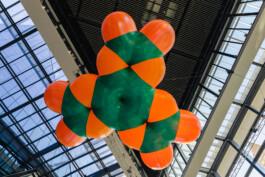







2023, Five inflatable sculptures
BENZENE FLOAT
Is it possible to visualize the influence that the petrochemical industry has on our lives in the modern world? The product of this multinational operation births a myriad of substances: gasoline, benzene, naphthalene, propane, asphalt, tar, and countless more mutations. These chemicals are so integrated into our day-to-day lives that they remain invisible to us, hovering in the background of our immediate field of vision, secretly fueling our activities like magical spirits or ghosts.
In BENZENE FLOAT, such an equation of deception and mystery is turned on its head by an exaggeration of the power of air: five larger-than-life sculptures depicting petrochemical compounds are inflated into absurd shapes and sizes, creating a visual spectacle of shimmering, reflective surfaces suspended in space. Reminiscent of the grand decorative floats of festival parades, they portray the scientific drawings of the molecular structure of these substances (named “space-filling models” in chemical terminology). Often based on single microscopic samples, these models have been blown up to huge scales here, some over six meters in length.
Their disproportionate size, coupled with their colorful fabric exteriors, highlight the immense influence these chemicals have on contemporary life—as agents of both convenience and destruction. Forcefully capturing the viewers’ attention, they dominate the space with an absurd, playful, and dramatic composition that betrays logic and decency.
Commissioned by Kunsthaus Bregenz, supported by ICD Brookfield Place








2023, Five inflatable sculptures
BENZENE FLOAT
Is it possible to visualize the influence that the petrochemical industry has on our lives in the modern world? The product of this multinational operation births a myriad of substances: gasoline, benzene, naphthalene, propane, asphalt, tar, and countless more mutations. These chemicals are so integrated into our day-to-day lives that they remain invisible to us, hovering in the background of our immediate field of vision, secretly fueling our activities like magical spirits or ghosts.
In BENZENE FLOAT, such an equation of deception and mystery is turned on its head by an exaggeration of the power of air: five larger-than-life sculptures depicting petrochemical compounds are inflated into absurd shapes and sizes, creating a visual spectacle of shimmering, reflective surfaces suspended in space. Reminiscent of the grand decorative floats of festival parades, they portray the scientific drawings of the molecular structure of these substances (named “space-filling models” in chemical terminology). Often based on single microscopic samples, these models have been blown up to huge scales here, some over six meters in length.
Their disproportionate size, coupled with their colorful fabric exteriors, highlight the immense influence these chemicals have on contemporary life—as agents of both convenience and destruction. Forcefully capturing the viewers’ attention, they dominate the space with an absurd, playful, and dramatic composition that betrays logic and decency.
Commissioned by Kunsthaus Bregenz, supported by ICD Brookfield Place